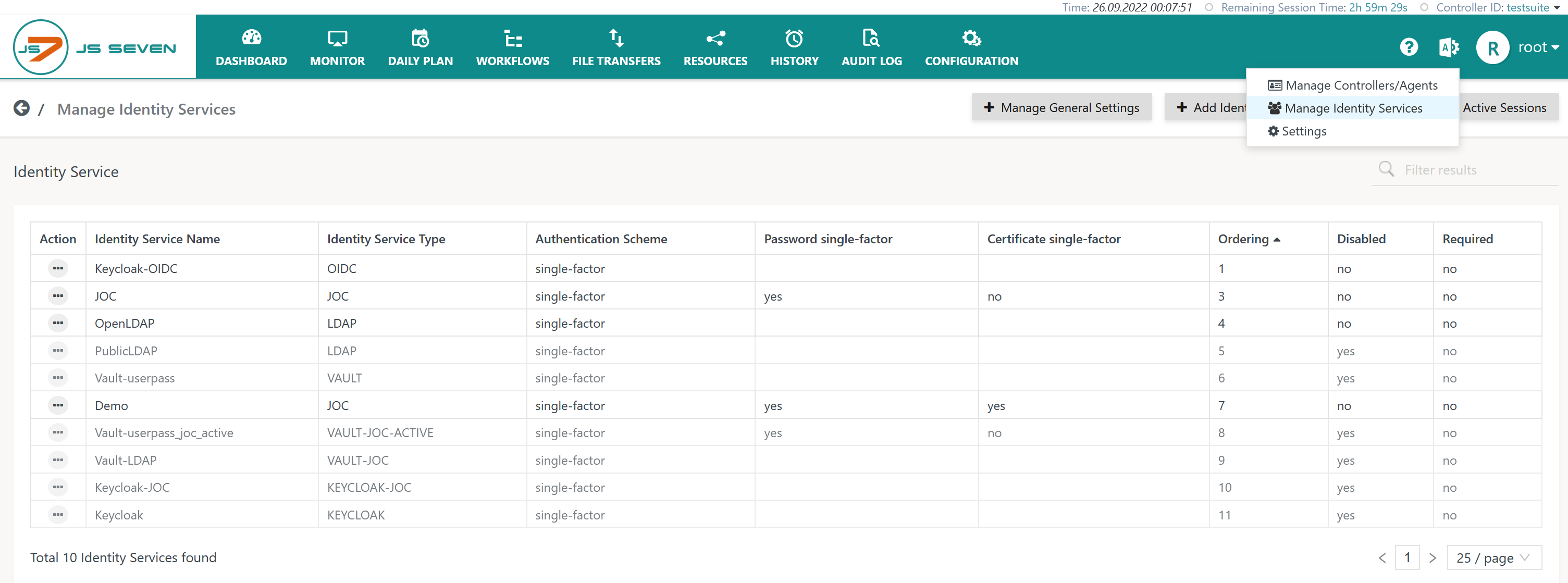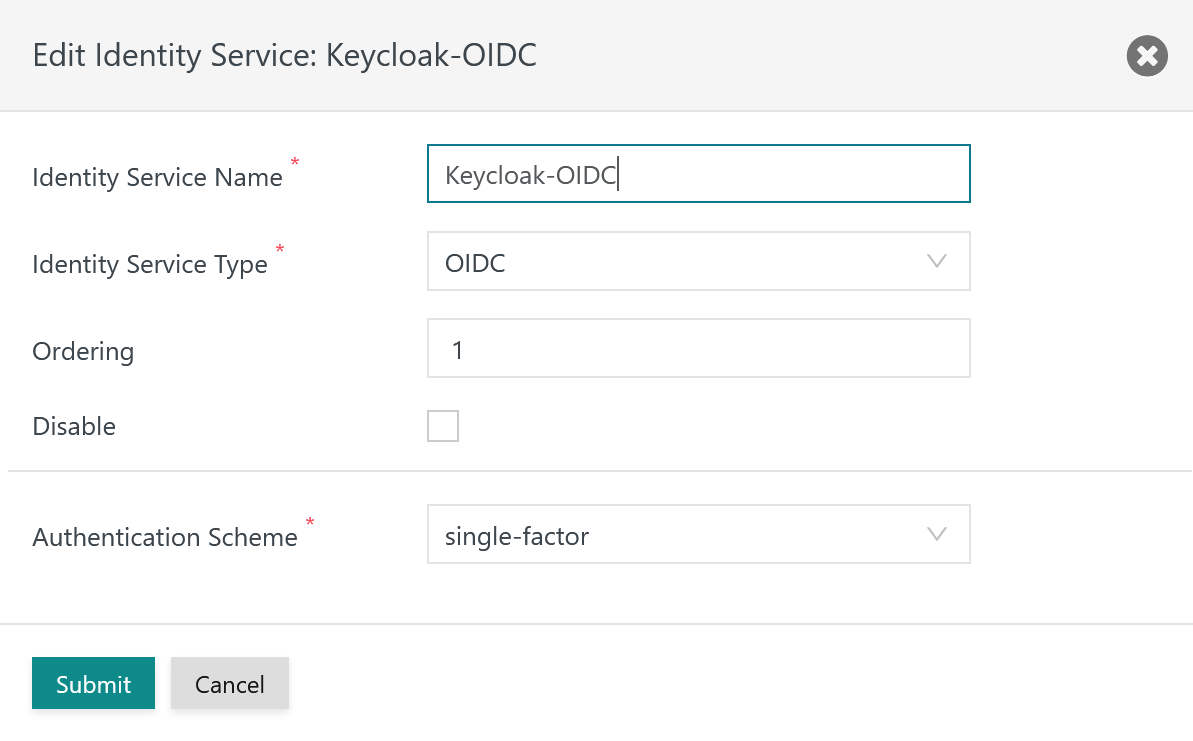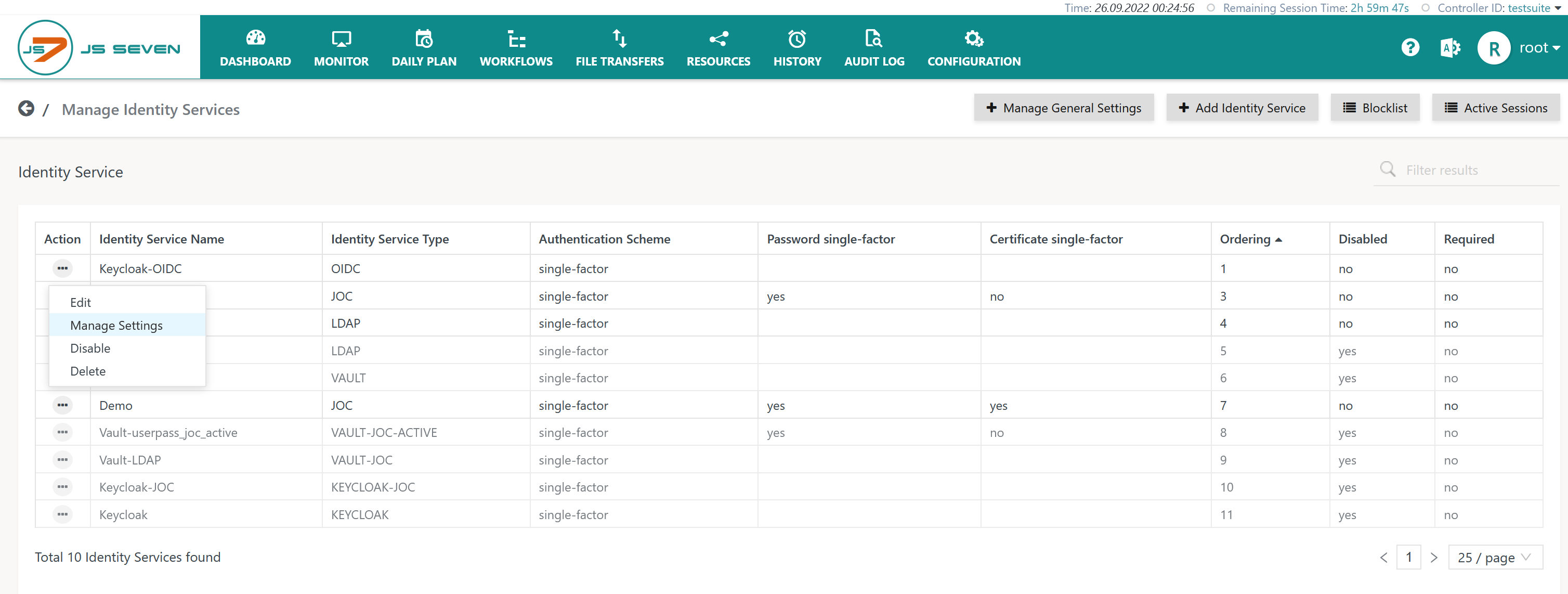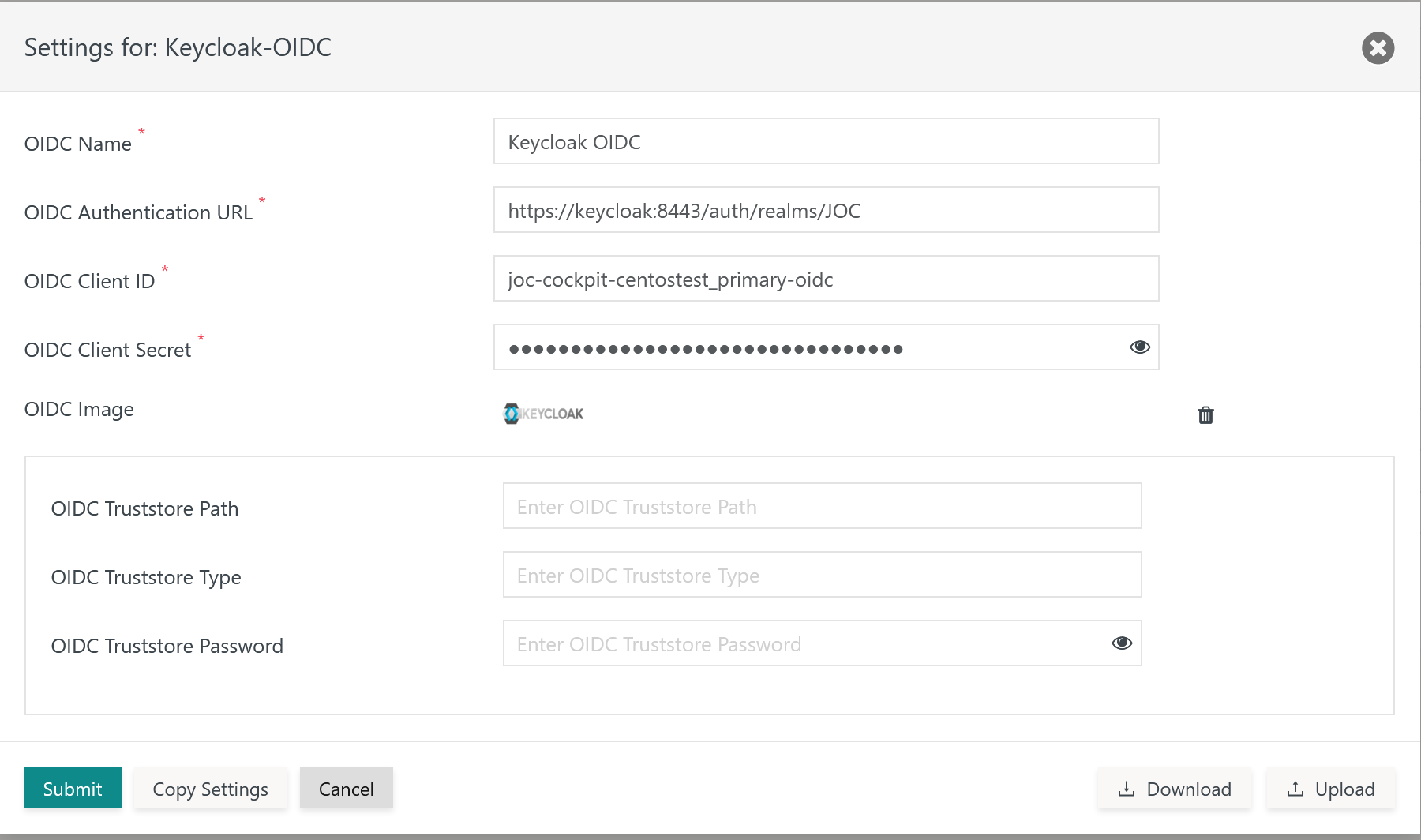Introduction
- The JS7 - Identity Services offer local management of user accounts for authentication and authorization.
- The OIDC Identity Service integration is available from JOC Cockpit:
- Any OIDC compliant Identity Provider can be used for authentication.
- This requires an OIDC Identity Provider to be installed and operated. JS7 does not ship with an OIDC Identity Provider.
- JS7 implements a REST client for use with OIDC Identity Providers.
Terminology
OIDC knows of the following roles involved in authentication:
- The Identity Provider is a system external to JS7 that provides authentication services for user accounts.
- The Client is the JOC Cockpit GUI that performs login/logout with the Identity Provider and that receives tokens from the Identity Provider in case of successful login.
- The Application is the JS7 - REST Web Service API that is handed over tokens by the Client and that verifies tokens with the Identity Provider.
Identity Service Type
The following integration level is available from the OIDC Identity Service Type:
| Identity Service | Identity Service Configuration Items | ||||
|---|---|---|---|---|---|
| Service Type | Built-in | User Accounts/Passwords stored with | User Accounts/Passwords managed by | Roles/Permissions stored with | Roles->User Accounts Mapping managed with |
| OIDC | yes | OIDC Identity Provider | OIDC Identity Provider | JS7 Database | JOC Cockpit |
Explanation:
- Service Type:
OIDC- Management of user accounts with passwords is performed by the OIDC Identity Provider
- The assignment of roles to user accounts is performed by the JOC Cockpit Client.
- The JOC Cockpit stores user accounts and role assignments: in the JS7 - Database.
- The JOC Cockpit does not know passwords of user accounts.
Identity Service Configuration
The icon in the JOC Cockpit main menu is used to select the Manage Identity Services page:
Add Identity Service
To add an Identity Service use the button Add Identity Service from the page shown above, listing the available Identity Services:
The remaining input fields for the popup window look like this:
Explanation:
- The
Identity Service Nameis a unique identifier that can be freely chosen. - The
Identity Service Typecan be selected as available from the above matrix. - The
Orderingspecifies the sequence in which a login is performed with available Identity Services. - The
Disabledattribute specifies if the respective Identity Service should not be considered by JOC Cockpit. - The
Identity Service Authentication Schemeallows to selectsingle-factorauthentication: user account and password are specified for login with the Identity Service.two-factorauthentication: in addition to user account and password a Client Authentication Certificate is required - see the JS7 - Certificate based Authentication article for more information.
Identity Service Settings
Having added an OIDC Identity Service it is necessary to add settings for the OIDC integration from the Identity Service's Manage Settings action menu item:
For use with the OIDC Identity Service Type:
- the OIDC Identity Provider product has to be installed and has to be accessible for JOC Cockpit and
- the following settings have to be specified:
Explanations:
| Name | Value | Description | Example |
| OIDC Name | The name of the OIDC Identity Service. | This is the name of the Identity Service. It is used by JOC Cockpit to show the caption of the assigned login button. | Google, Keycloak |
| OIDC Authentication URL | The URL used by the Client to login to the OIDC Identity Provider. | This URL is called by the Client for login and returns the Access Token from the OIDC Identity Provider. It is similarly used when reading settings of the OIDC Identity Provider with the /.well-known/openid-configuration URL and is used as the issuer during token verification. | https://keycloak:8283/auth/realms/JOC |
| OIDC Client ID | The Client ID is configured in the OIDC Identity Provider. | The Client ID is used for a number of calls to to the OIDC Identity Provider. |
|
OIDC Client Secret | The Client Secret is configured in the OIDC Identity Provider. | The Client Secret is used for a number of calls to the OIDC Identity Provider. |
|
| OIDC Token Verification URL | This URL is used to verify the Access Token. | If empty then the "introspection_endpoint" value from the response of a call to the
The response must contain the field "active", The value of the field is expected to be "true". | https://keycloak:8283/auth/realms/JOC/protocol/openid-connect/token/introspect |
Identity Service Processing
Login
If login is performed with an OIDC Identity Service then
- the list of required Identity Services will not be considered by JOC Cockpit.
- the login is tried with the given OIDC Identity Service only. Other Identity Services will not be considered.
- OIDC Identity Services cannot be set to be "required".
Token Verification
The login call returns the following tokens to the Client:
- Access Token: A token returned after successful authentication by the Client.
- ID Token: A JWT Token with Header.Payload.Signature is expected.
- Refresh Token: A token used by the Application to renew the Access Token.
After successful login of the Client the OIDC Token Verification URL is called by the Application with the following settings:
- Client ID
- Client Secret
- Access Token
Processing of the response and verification of the token is performed by the following steps:
- Checking if the response contains the field "active". The value of the field is expected to be "true".
- Checking if the Access Token is not expired.
- Checking if the Client ID (aud) stored in the ID Token is the same as in the configuration of the Identity Service.
- Checking if the issuer (iss) stored in the ID Token is the same as the OIDC Authentication URL in the configuration of the Identity Service.
- Checking if the account (e-mail) stored in the ID Token is the same as in the field "email" in the answer of the userinfo endpoint.
- Checking if the signature is valid with the given public key. The certs endpoint is the value of jwks_uri in the response of the /.well-known/openid-configuration call. The response of the certs endpoint includes a number of keys. The public key is calculated from the key entry using the value for n and e of the correspending array element where the kid value matches the kid value in the token header.
Token Renewal
The token contains the value when it will expired. 20s before this happens, the token will be renewed.
When the token can not be renewed, the JOC Cockpit Session will be revoked.
The token can not be renewed, when
- the session have been cancelled in the Identity provider.
- There is no valid session_token
Examples for Use with Identity Providers
Adding a Client to the OIDC Identity Provider
It is required to configure a Client in the OIDC Identity Provider. The Client specifies the given Client ID and Client Secret during login. To achieve this, the token endpoint is called with
- client-id: The client id that is configured in the JOC Cockpit Identity Servicy
- client-secret: The client secret that is configured in the JOC Cockpit Identity Servicy
- grant-type: refresh_token
- refresh-token: The refresh token that have been provided in the header of the login call.
The JOC-Cockpit sessions expiration time is configured in the JOC Cockpit global settings for Identity Services.
When the session in the Identity Provider is no longer valid, the JOC Cockpit session will end at the point of time when the next session renewal is executed.
Keycloak Identity Provider
Settings
- Open Clients View
- Create a new Client with the "Create" button
- The following values are approved
- Enabled: on
- Standard Flow Enable: on
- Valid Redirect URL: JOC Cockpit URL, for example https://joc-primary:4446/joc
- Web Origin: For example https://joc-primary:4446/joc
Credentials
- Client Authenticator: Client ID and Client Secret
- Secret: Generated secret value
After setting up the Client users can be added in Keycloak's "Users" view.
Vault Identity Provider
TBD
Logging
- Log Files
- Standard Log Files
- Identity Services log output to the
JETTY_BASE/logs/joc.logfile. This includes reporting success or failure of authentication. - Successful and failed authentication attempts including user accounts involved are logged to the
JETTY_BASE/logs/audit.logfile.
- Identity Services log output to the
- Debug Log Files
- For problem analysis during setup of an Identity Service increase the log level as explained with JS7 - Log Levels and Debug Options.
- The
JETTY_BASE/logs/joc-debug.logfile includes general debug output of JOC Cockpit. - The
JETTY_BASE/logs/authentication-debug.logfile includes debug output related to authentication and authorization. - The
JETTY_BASE/logs/jetty.logfile includes debug output of attempts to establish SSL connections.




